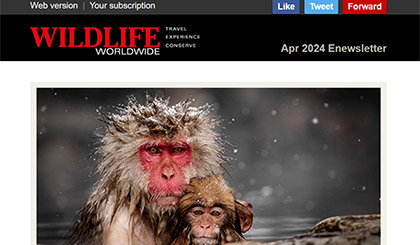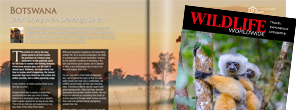Wildlife & Nature Photography in the Peruvian Amazon
In November 2017, Tony joined our wildlife photography trip to Peru, led by rainforest lover and wildlife photographer Nick Garbutt, in conjunction with Alex Hyde, master of macro and flash. Here Tony gives us a comprehensive insight into these three memorable weeks that took him down the eastern slope of the Andes into the heart of the lowland rainforest of the Amazon basin.
The Peruvian Amazon
This is an area of South America that I’ve always been interested in, but somewhere I thought I’d never visit. With the extent of the Andean Mountain Range and the sheer size of the Amazonia region as a whole, you’re only ever going to get a brief glimpse of this wonderful world during a trip of this type. But this particular tour had been well-thought-out with an itinerary that would allow us to experience the various habitats, by starting in the high Andes and then making our way slowly down through the mid-elevation cloud forest and then onto the rivers that would eventually take us deep into the remote areas of the rainforest.
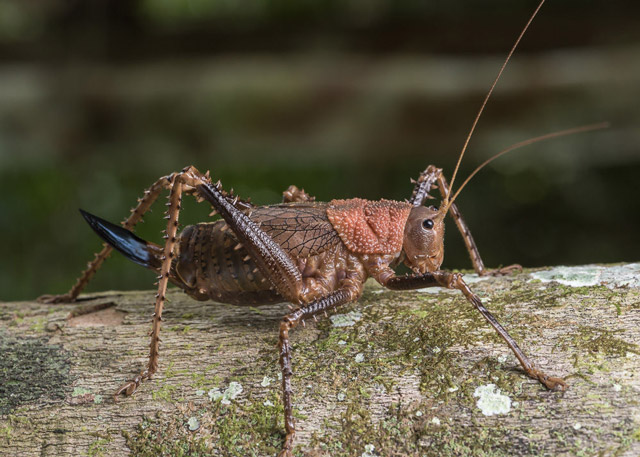
The journey started with a flight via Madrid and Lima to the ancient Andean town of Cusco, where we were met and transported to a small hotel for the night, Cusco is the former centre of the Inca Empire. It’s one of the highest towns in the world at an altitude of around 3,400 metres and, consequently, you have to be mindful of the fact as most people will feel the effect to one degree or another. After booking in at our hotel and meeting the rest of our small party we took the opportunity of walking down the rather steep, narrow cobbled street from the hotel to the main square. Walking back up wasn’t as easy! But, interesting as Cusco is, this was not the purpose of the trip, so after a communal dinner at a local restaurant, it was off to bed ready for an early start the next morning.
Andean Cloud Forest
After driving across town and then out of the Cusco suburbs, the first stage of our adventure took us took us off the main road onto an unmade dusty track through a wetland area where we stopped a few times in order to photograph local species such as plumbeous rail, cinnamon teal and yellow-billed pintail. We then continued on a narrow gravel road that took us across two mountain ranges between the Cusco Valley and the Paucartambo Valley. During this stage of the drive we reached an altitude of 3,900 metres near Acjanaco before starting the slow decent into the cloud forest.
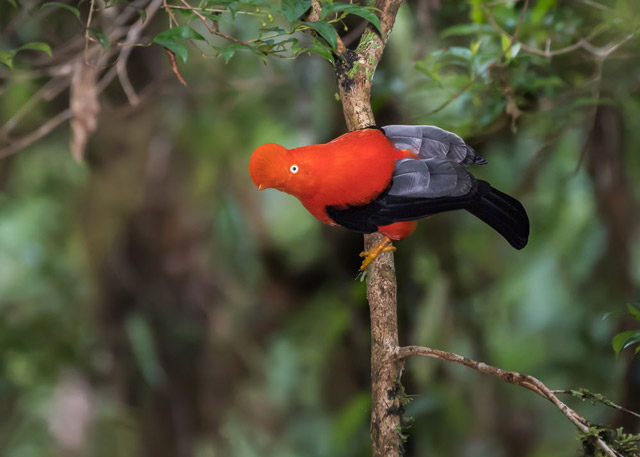
Our first destination was the Kosñipata Valley at a mid-elevation altitude of around 1,600 metres. Here we stayed three nights in a comfortable jungle lodge set within its own 5060-hectare private cloud-forest reserve close to a prime Andean cock-of-the-rock lekking site. This particular lek has been used by the birds for many years and is well-known for being one of the very best sites to see them. The birds would start to arrive at dawn, which obviously involved a very early start, stay a while and then return again mid afternoon. This allowed everyone at least two opportunities, which was fortunate as the morning sessions proved to be extremely short and rather unproductive. The afternoon sessions were much better as you could have as many as ten birds present at any time from around 3pm through to dusk. I enjoyed one morning and two afternoon visits.
Apart from the Andean cock-of-the-rock we were able to photograph a couple of species of hummingbirds within the lodge grounds, as well as a few insects, including various bush crickets or katydids, a shield mantis, plus a rather impressive white witch moth. But best of all, was a small troop of tufted (brown) capuchins that could be seen most mornings. These particular monkeys were reasonably used to people unlike the rest of our primate encounters and, as such, turned out to be the best monkey photo opportunities by far.
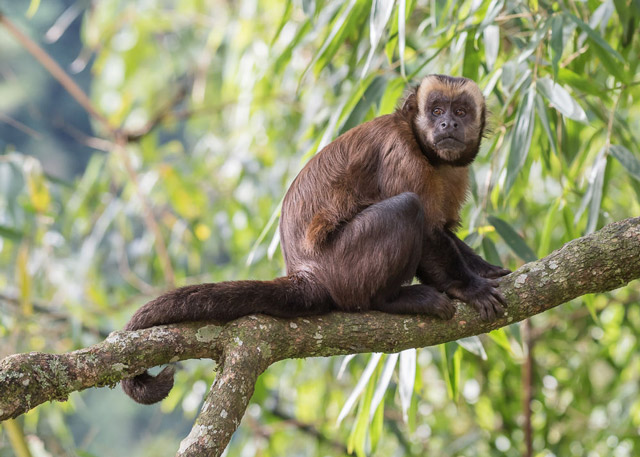
Arriving in the Amazon Rainforest
On day four we continued down the ‘road’ for another two hours or so to the small riverside town of Atalaya. From here on there are no roads, so our mode of travel was now by motorised canoe. Once all the luggage was loaded, we set off downstream on the Río Alto Madre de Dios towards our first rainforest lodge. Shortly after arrival we had the first macaw sighting, when a pair of blue-and-yellow macaws flew over and landed in one of the tall trees on the edge of the forest. Around the lodge grounds we spotted other species, such as speckled chacalaca, russet-backed oropendola and silver-beaked tanager, but none offered any real photo opportunities.
In the afternoon we walked down to a local oxbow lake, where we had our first sightings of the unique hoatzin, also known as the ‘stinkbird’, which is a strange pheasant-sized bird that spends most of its time in bushes close to the water’s edge, where its main diet is leaves and fruit. Whilst the hoatzin is undoubtedly an attractive looking bird, it’s pretty uninspiring as it doesn’t really do much other than sit around. I started likening it to the African helmeted guineafowl, often called ‘the stupid bird’, which is another attractive species, but with little intelligence. To add to the hoatzin's unusual behaviour, it’s also a noisy species, with a variety of hoarse calls, including groans, croaks, hisses and grunts. We were all pleased to see them, but by the end of the trip it was a case of “please, no more hoatzin photos”.
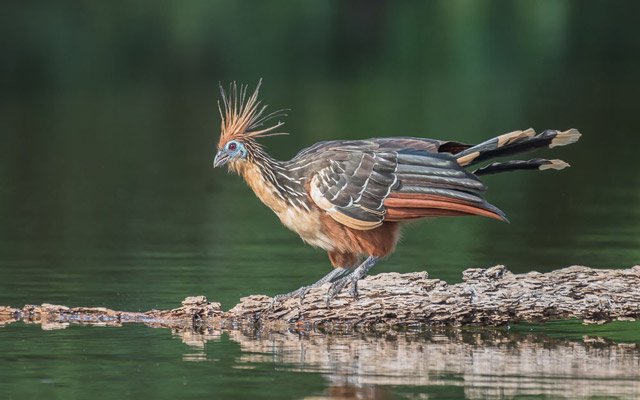
After loading up the boats we continued down the main river to our next overnight camp, which was the Romero Rainforest Lodge on the Manú River. Following some brief formalities, we started up the Manú River, which is somewhat slower and narrower than the main river and, consequently, more interesting. We were now in Manú albeit still not within the actual reserve. As we came round the next bend in the river we spotted a lot of activity on an exposed rocky beach area about 200 metres or so in front. As we started getting closer we realised that they were vultures. There was a rare king vulture there as well, but annoyingly it flew off to a distant tree before we got close. All the other birds, about a dozen or so, were black vultures. Although we couldn’t see clearly, our guide was pretty sure that they’d found a dead bush dog near the shoreline. It was still fresh and the thinking was that the black vultures had to wait for the larger and stronger king vulture to come in and, in effect, open up the 'kill'. The black vultures would have held back, but as soon as they could see the king vulture feeding they would have mobbed it. By the time we arrived the black vultures were all over it, heads down. The king vulture didn’t come back to the ‘kill’, but it did circle overhead for a while so at least I got a couple of reasonable ‘record shots’ of it in flight.
Manú National Park
The following day saw us back on the river again where we continued upstream to the so-called ‘tented camp’, which is a simple, but comfortable, low-impact lodge that was to be our base for the next three days. We were now on the middle reaches of the Manú River and finally inside the official border of the Manú National Park and Biosphere Reserve. The Manú Park Wildlife Centre is the only tourist accommodation within the actual park boundaries - the other local lodges are all in the adjoining ‘buffer zone’. Our group of 15, including the tour leaders, had full occupancy of the camp. Unlike the other lodges on this trip, we expected tents and shared facilities at this location, so we were surprised to find ourselves in another small individual cabin with our own private bathroom. It was a good base with a central meeting area and dining room where we enjoyed remarkably good food given the remoteness of the location.
Despite the diversity and abundance of wildlife that can be found in the rainforest, it’s amazing how little you actually see when travelling along the river or when walking the trails. It’s certainly a completely different experience from the more open areas of the Southern Pantanal. The most surprising aspect for me was the lack of birds, particularly waterbirds which I thought we’d see in abundance. However, as we’d found the day before, the Manú River was more productive than the upper reaches of the much wider Madre de Dios, and on the way upstream we had another couple of good sightings of two new species. The first was a blue-throated piping-guan that was busily picking at clay - for the same reasons as the parrots and macaws - on an exposed river bank, and shortly after a lone Orinoco goose who was close to the shoreline.
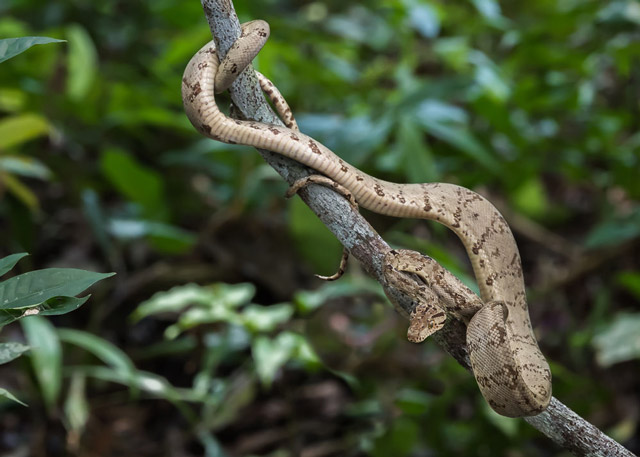
The area in which we were staying was near to the beautiful Cocha Salvador. Given that it’s one of only a couple of properly accessible areas of interest, it’s obviously popular with visitors and, therefore, groups have to agree visiting times with the ranger. Fortunately we were travelling at the end of the season and, as such, visitor numbers were low, so we were able to go there twice. After a short walk through the forest you reach the lake where there’s a small jetty and a floating pontoon that’s basically a large stable platform that’s been mounted on two canoes thereby forming a small catamaran that can be paddled slowly and silently across the lake. It was both peaceful and enjoyable and we did have sightings of such species as hoatzin, anhinga, jacana and sunbittern, as well as a close encounter with the resident giant otter family. We also had our only sighting of black spider monkey and our first of only two sightings of red howler, both high in the canopy and difficult to photograph. Back at the lodge we got to photograph other species including an Amazon tree boa and a three-striped poison frog, plus an unexpected visit early one afternoon by a troop of woolly monkeys that were making their way through the trees at the back of the cabins.
Manú Wildlife Centre
We’d arrived in Cusco on Friday 10th November and it was now Monday 20th and we were just over half way through the trip, so it was time to leave the tented camp and head back downstream to the Río Madre de Dios and onto the Manú Wildlife Centre. This turned out to be a good boat ride as we had a rare sighting of a tapir that had come out of the forest with the intention of crossing the river. Fortunately it was just at the water’s edge when our boatman spotted it in the distance - if we’d been a minute or so earlier we would either have missed it or frightened it off, and a few minutes later we would also have missed it. But our arrival time was perfect so we were able to hold position in mid river to watch it swim across and clamber up the opposite bank. This was an experience that few people get to witness.
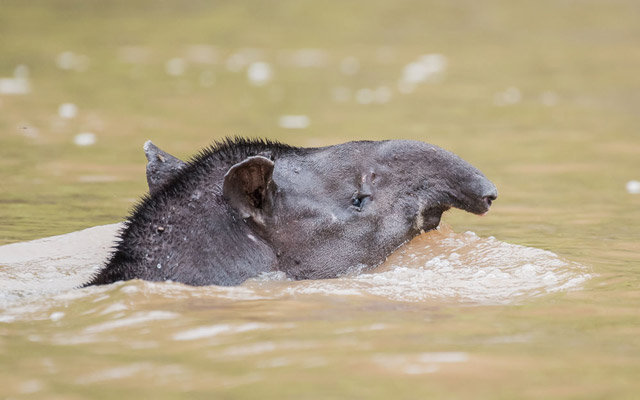
Shortly after that encounter we had good sightings and photo opportunities with horned screamer, razor-billed curassow and a jabiru stork all within a short distance. The other boat was behind us and missed all these sightings, albeit later on they had the very good fortune to spot a jaguar. It was a very brief sighting at distance on the far bank, but it was the sighting that everybody wants. Whilst these large cats are now regarded as relatively common in certain areas of the Northern Pantanal, they are exceptionally difficult to see anywhere else - I’m still waiting for my first sighting. The Manú Wildlife Camp was a pleasant surprise as both the accommodation and central lodge area were of a standard we didn’t expect in the middle of the rainforest.
The main attraction here was the famous Blanquillo clay-lick where every day dozens of parrots and macaws gather in order to eat clay, which they need to neutralise their pH that has been acidified as a consequence of their diet. The smaller birds always arrive first - parakeets, then parrots. The macaws will then start gathering until there are between 30-40 of them, sometimes more, before the first birds decide that it is safe to drop down to the clay bank. We didn’t understand why the birds were so nervous until our guide informed us that there was a resident ocelot, which unfortunately we didn’t see, that regularly hides in the undergrowth above the bank where it can make a surprise attack on any unsuspecting bird. Whilst there are four or five species of macaw in this area, it is predominantly the red-and-green Macaw that come to this particular colpa. The site is perfect being in a narrow, almost cut-off channel, where viewing is from a large, open-fronted, purpose-built raised platform hide. I had two sessions here.
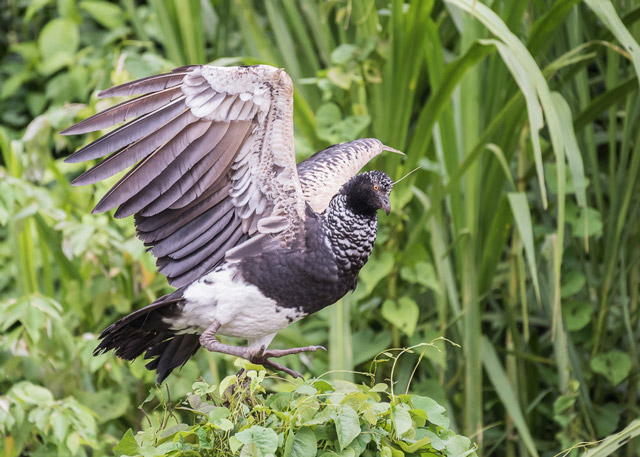
On the first day we managed to get our canoe up the channel, but on the second day the river had dropped and the boatmen said that they wouldn’t be able to turn the canoes around and, as such, we would have to be dropped off on the main river bank and take a walk through the forest - an enjoyable experience, just as it was getting light. At one point we encountered a troop of squirrel monkeys as they made their way through the tree tops to cross the path. Within the forest around the lodge we got to photograph various strange critters including a leaf-mimicking katydid and a beautiful bicoloured tree-frog, more commonly known as the giant monkey frog.
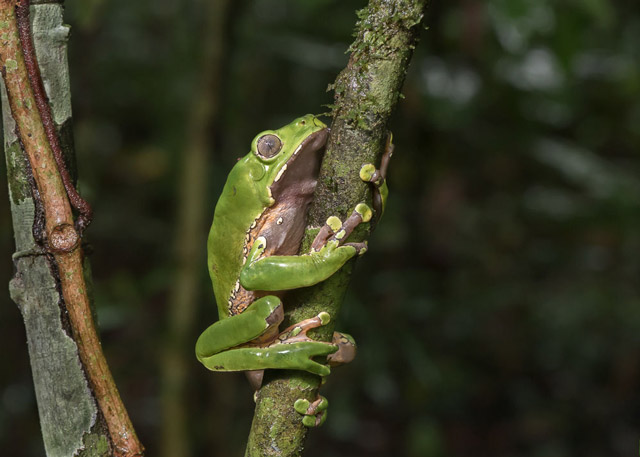
Tambopata
Having departed the Manú Wildlife Centre early the previous morning we were now in Puerto Maldonado, ready for the fifth and final leg of our extended trip. The journey out of Manú had been interesting as it involved transfers by motorised canoes, cross-country jeeps, ferry boats and finally by road. The various pickups, coupled with the seemingly endless movement of luggage from one mode of transport to the next, were all on time and extremely efficient. We'd elected to stay on with a few others in order to have a further five days to experience the adjoining area of Tambopata and the Bahuaja-Sonene National Park, so today we set off again by motorised canoe for what turned out to be a long, and rather wet, trip down the Río Madre de Dios to the Peruvian-Bolivian border posts set either side of the Heath River. After brief formalities we then turned up the Heath River for another two hours or so before reaching our final lodge where we’d be staying for the next four nights.
Our main interest in this area was the Heath River macaw and parrot clay-lick and another local oxbow lake, both of which were situated on the Peruvian side of the river, whereas our lodge was actually on the Bolivian side within the Madidi National Park. The clay-lick was really good, better in fact than the famous Blanquillo site that we’d been to in Manú. It was in an off-shoot of the main river that we again had to access via a narrow shallow inlet, but this time the viewing point was a floating hide that was moored at a more reasonable distance from the river bank. The species though were much the same as we’d seen at Blanquillo, so there wasn’t really anything new or different. However, it was a great spectacle and unforgettable experience, so I took the opportunity of going on each of the three mornings we were there. The oxbow lake was again equipped with a floating pontoon from where we were able to photograph more hoatzin plus a few other species. And, on the trail behind the lodge, we had some reasonable views of both tufted capuchin and black-capped squirrel monkey - the latter also being called the Bolivian squirrel monkey, which was apt given that they were on the Bolivian side of the river.
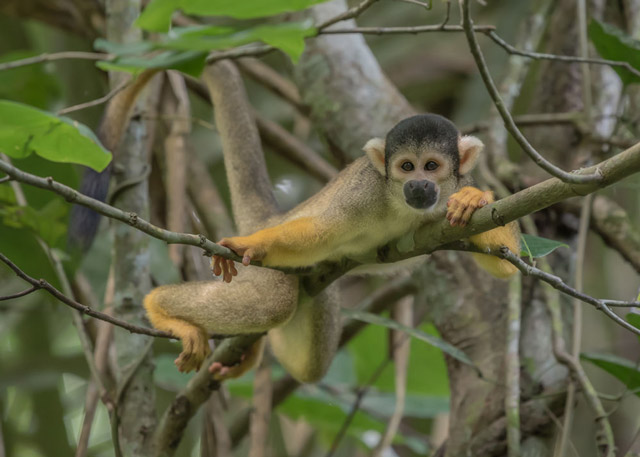
It was now Wednesday 29th November and we’d been away from home for the past twenty days so, despite having some regrets, it was time to pack up and make the long river trip back to the small airport at Puerto Maldonado where we had a late afternoon flight to Lima in order to connect with our international flights back to London.
Summary
This was a long, tiring, but rewarding trip. We saw a lot although, if I’m honest, not as much as I thought we’d see. The problem is that you read books and see programmes on television about the Amazon and all the wonderful creatures that live there, and assume that you’ll see many of these species if you go. The reality is different. In the rainforest, close encounters are actually pretty rare. On the riverbanks and oxbow lakes you stand more chance, but even here most of the creatures are very timid. Any sighting becomes a good sighting. It therefore goes in hand that photographing any of the wildlife is very difficult indeed. Wildlife photography isn’t easy - if it was it wouldn’t be a challenge and wouldn’t be as rewarding as it is.
At the end of the trip I’d taken around 7,500 photos of which well over half were taken at the two clay-licks. After culling and editing I kept 1,500. Of those I’d rate around 200 or so as being good shots. I’m more than happy with that return. I was also happy to add many new species to my 'World Bird List' - apart from those specifically mentioned in the above text there was Andean motmot, purple gallinule, black-capped donacobius, giant hummingbird, ladder-tailed nightjar, chestnut-fronted macaw and southern mealy parrot, to name but a few. In total I photographed 71 different species. I also had some good animal encounters. Primates are always difficult, so to get at least one good publishable photo of each of the five target species (tufted capuchin, squirrel, spider, woolly and red howler) was really satisfying. Then there was also a surprise encounter with an Andean fox and the tapir that swam across the river. And, last but not least, quite a few smaller creatures including the Amazon tree boa, various frogs, a pinktoe tarantula and a number of interesting invertebrates.
All images by Tony Enticknap
Join Nick Garbutt in 2020 on this exceptional wildlife and rainforest photography tour to the Peruvian Amazon.

